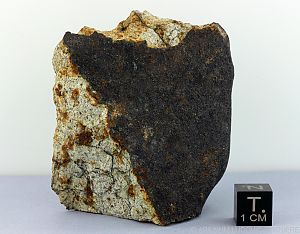First "Austro" meteorite recovered in Styria since 1977
Also from a scientific point of view the finding of the chondrite, which according to first analyses at the NHM is actually an ordinary one, is a "stroke of luck". But the finding of the meteorite piece itself is already such a stroke of luck. On November 19 of the previous year at 04.46 o'clock a fireball was to be seen over Austria. At that time Ferrière received numerous reports about observations of the rare phenomenon. There were also reports of loud explosion and rumbling sounds and sightings of a dust tail. The nocturnal occurrences were also registered by a number of specialized meteor cameras of the "AllSky7" fireball network, the FRIPON (Fireball Recovery and InterPlanetary Observation Network) meteor observation network and the European Fireball Network.
Evaluations by the network, led by Pavel Spurný of the Academy of Sciences of the Czech Republic, quickly determined what must have happened when the fireball passed through the Earth's atmosphere. The scientists estimated the original weight of the celestial body at about 270 kilograms. For 24 seconds, the chunk was visible as a glow as it fell from an altitude of 100 kilometers high to 25 kilometers. At the estimated speed of 14 kilometers per second, however, most of the mass burned up. The rest should have fallen in mostly small fragments in a mountainous area about 50 kilometers long and up to three kilometers wide between the municipalities of Lunz am See (Lower Austria) and Kindberg (Styria).
Search for remnants
Ferrière immediately assembled a small team to search for remnants in the area. This was citizen science par excellence - an approach that has a long tradition in his field of research, said the researcher. However, nothing was found at the time. However, the local population was subsequently to keep an eye out for characteristic black-colored rock fragments. Indeed, a small race against time also unfolded, because the longer an impact dates back, the more likely it is to be overgrown by vegetation or to change the appearance of the usually unusual-looking boulders with a black outer shell.
"Several dozen people have contacted us at the museum since the fireball was seen, but none of the rocks found were meteorites," the scientist said. Finally, eight months after the fall, a person who had been in contact with Ferrière during the initial searches came forward with the crucial find. Immediately, Ferrière and his colleague Julia Walter-Roszjár drove to Kindberg to examine the rock and search further. The broken rock indeed shows the typical black fusion crust and a gray interior with shiny metal grains, as well as some thin fusion veins, the scientists said.
However, no other pieces have been found so far. "There should be more there, though. Because on the video of the crash, you can see that there was fragmentation," Ferrière said. The piece now found was indeed in the exact area that the analyses suggested, he said. However, it is doubtful that further fragments will be found in the mountainous region in the near future - also because many people from numerous countries have already participated in the search.

Exceptional find
For Austria the find is "only number eight and therefore a real exception", Ferrière emphasized. Although several tens of thousands of meteorites have been found worldwide, the case here is exceptional in international comparison. Based on the numerous observations, it was possible to calculate the orbit of the original object around the Earth. So far this was the case only with about 40 such occurrences of approximately 60,000. After the discovery of the first remains one could deliver also further data to it, the scientist was pleased.
In many cases, one only has the material for analysis without knowing where exactly it was found, the geologist said. The "Kindberg meteorite" is a representative of the Apollo asteroids. Thus it comes from the same group as the Chelyabinsk meteorite, which fell spectacularly in February 2013. The latter had a diameter of about 20 meters when it crashed over Russia. According to Ferrière, this group can be "virtually traced back on the basis of samples. It's a little bit like getting a free return space mission from an asteroid." Such missions promise to bring back fewer grams of samples, but at a financial cost of many millions of euros.
Since the event was registered by so many people in Austria and has now also unearthed a new "Austro" meteorite, the curator hopes to attract more attention to the area in the future, even among young people. To ensure that more of these spectacular celestial phenomena are registered soon, scientists are continuing to lobby for the expansion of a network of sky observation cameras. "Tomorrow I will get five more such cameras," Ferrière said.
Meanwhile, the meteorite has been submitted to the Meteoritical Society for approval. After the positive decision, it will then be officially listed as a "Kindberg meteorite." Should any suspicious material turn up in the area where it was found, the researchers ask for reports via the museum website.
